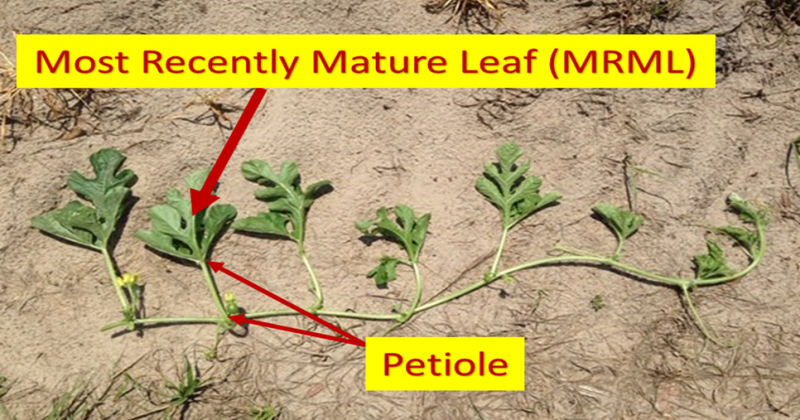Bob Hochmuth with input from Suwannee Valley Extension Agents: Mark Warren (Levy), Tyler Pittman (Gilchrist), Tatiana Sanchez (Alachua), Luke Harlow (Union), Jay Capasso (Columbia), Dan Fenneman (Madison), Keith Wynn (Hamilton), Danielle Sprague (Jefferson), Emily Beach (Lafayette), Amanda Phillips (Suwannee), Kevin Athearn (RSA-Agri- business), and Sudeep Sidhu (RSA- Water Resources).
Time to start petiole or leaf tissue analysis
Watermelon vines in many fields are growing off the plastic beds now, so we recommend starting to look at nutrient levels to determine when to start a routine fertigation program. Many producers and consultants use tissue sampling as an important management tool for in-season fertility assessments. Like sap testing, it is important to recognize that tissue tests are just a snap-shot view of the crop at the time the sample was collected. Results can be affected by many factors (time of day, cloud cover, stage of maturity, time since last fertilizer application). Tissue analysis and petiole-sap tests are most valuable when taken consistently, routinely, and then considered over time.
Sample collection is the most critical part of the process. Representative samples are essential. Avoid taking samples from areas that have symptoms not related to nutrition (disease, cold, insect, drought, etc.) Some labs may suggest different sampling protocols (whole plant, petiole, full leaf), but UF/IFAS research, including the nutrient sufficiency/ deficiency ranges, are based on samples of the “most recently matured leaf” (MRML). Regardless of the lab that you choose, you should submit samples using the MRML (the 5-6th leaf from tip), as these will most accurately correlate to the published information for Florida crops and conditions. Samples should be 15-20 leaves. Full leaf samples should be submitted in paper bags. If petioles are being collected for sap, upon collection they should be immediately removed from the leaf blade and held in a plastic bag. If not tested immediately, petioles should be stored in a cooler or refrigerator.
–
When nutrient related stress is suspected, it is best to submit a “good” versus “bad” set of samples, so that the results can be compared. For watermelon whole leaf analysis at first flower, we recommend the nitrogen (N) levels be in the range of 2.5-3.5%, and potassium (K) levels between 2.7-3.5%. Adapted from, Plant Tissue Analysis and Interpretation for Vegetable Crops in Florida. HS964. When using plant petiole sap tests, at or before first flower, we recommend the nitrate-N levels be between 1200 and 1500 ppm and the K levels between 4,000 and 5,000 ppm. UF/IFAS Extension Agents in the Suwannee Valley are ready to begin petiole-sap testing at growers’ requests. So let your Extension agent know when you are ready for sap testing. (Mark Warren and Bob Hochmuth)
–
Disease and Insect Updates
Extension Agents and industry field personnel generally report this past week the watermelon crop is still mostly free of insects and disease, other than fields where transplants were infected with gummy stem blight, and a few isolated cases of Pseudomonas bacterial leaf spot. Many of the plants still look pretty rough from the freeze damage and constant wind abrasion, but these plants have pushed new growth and seem like they are doing as well as could be expected. Unless growers have a specific disease established, we suggest you consider chlorothalonil (Bravo or other generic) this week. We realize Miravis Prime may be another option in future sprays ahead of infections, however, it is more expensive. We are concerned about more expensive options this year, unless needed, especially given the high inputs and uncertain market.
This is the time to also be on the lookout for adult squash bugs emerging from woodlands and field perimeters. Be sure to let us know if you need insect or disease samples collected for ID or analysis. (Tatiana Sanchez and Bob Hochmuth)
- 2024 Watermelon Season Wrap Up - June 21, 2024
- Weekly Watermelon Update – June 3 - June 7, 2024
- Weekly Watermelon Update #10 – May 20 - May 24, 2024

